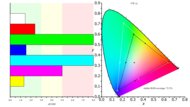Notice: Your browser is not supported or outdated so some features of the site might not be available.
Notice: We're looking for passionate writers and testers to join our team. Apply now!
- Table of Contents
- Top
- Main Differences
- Design
- Picture Quality
- Motion
- Inputs
- Features
- Comments
Dell U3417W vs ASUS ROG Swift PG348Q
Side-by-Side Comparison
Products
Dell U3417W
ASUS ROG Swift PG348Q
Tested using Methodology v1.0
Updated Mar 20, 2023 05:02 PM
SEE PRICE
Amazon.comTested using Methodology v1.0
Updated Sep 08, 2021 06:23 PM
SEE PRICE
Amazon.comSize34"
LCD TypeIPS
Variable Refresh RateNo
Native Resolution3440 x 1440
Native Refresh Rate60 Hz
Size34"
LCD TypeIPS
Variable Refresh RateG-Sync
Native Resolution3440 x 1440
Native Refresh Rate60 Hz
Variants
- U3417W (34")
- PG348Q (34")
Our Verdict
Dell U3417W
ASUS ROG Swift PG348Q
The ASUS ROG PG348Q is a bit better than the Dell U3417W. The PG348Q has much better motion handling, with a faster response time and higher refresh rate, as well as NVIDIA G-SYNC VRR support. The ASUS also has much lower input lag, making it a much better gaming monitor overall. The ASUS also has a better stand that can also swivel, great for sharing work with someone else.
Main Differences forMixed Usage
Mixed Usage
Threshold
Mixed Usage
7.4
7.6
Input Lag
7.9
9.1
Full Comparison
Design
Picture Quality
Local Dimming
0.0
0.0
Local Dimming Video
Local Dimming
No
No
Backlight
Edge
Edge
SDR Peak Brightness
8.0
7.6
SDR Real Scene
349 cd/m²
294 cd/m²
SDR Peak 2% Window
366 cd/m²
325 cd/m²
SDR Peak 10% Window
364 cd/m²
326 cd/m²
SDR Peak 25% Window
361 cd/m²
326 cd/m²
SDR Peak 50% Window
359 cd/m²
326 cd/m²
SDR Peak 100% Window
357 cd/m²
326 cd/m²
SDR Sustained 2% Window
365 cd/m²
325 cd/m²
SDR Sustained 10% Window
361 cd/m²
326 cd/m²
SDR Sustained 25% Window
358 cd/m²
326 cd/m²
SDR Sustained 50% Window
356 cd/m²
326 cd/m²
SDR Sustained 100% Window
354 cd/m²
326 cd/m²
SDR ABL
0.002
0.000
HDR Peak Brightness
0.0
0.0
HDR Real Scene
N/A
N/A
HDR Peak 2% Window
N/A
N/A
HDR Peak 10% Window
N/A
N/A
HDR Peak 25% Window
N/A
N/A
HDR Peak 50% Window
N/A
N/A
HDR Peak 100% Window
N/A
N/A
HDR Sustained 2% Window
N/A
N/A
HDR Sustained 10% Window
N/A
N/A
HDR Sustained 25% Window
N/A
N/A
HDR Sustained 50% Window
N/A
N/A
HDR Sustained 100% Window
N/A
N/A
HDR ABL
N/A
N/A
Horizontal Viewing Angle
7.5
7.8
Horizontal Viewing Angle Video
Color Shift from Left
44°
47°
Color Shift from Right
40°
47°
Brightness from Left
51°
53°
Brightness from Right
50°
53°
Black Level from Left
75°
75°
Black Level from Right
75°
75°
Curve Radius
1,900R
3,800R
Vertical Viewing Angle
8.5
7.8
Vertical Viewing Angle Video
Color Shift from Below
32°
25°
Color Shift from Above
31°
26°
Brightness from Below
39°
31°
Brightness from Above
37°
31°
Black Level from Below
75°
75°
Black Level from Above
75°
75°
Pre Calibration
8.2
5.5
Picture Mode
Multimedia
Racing Mode
Luminance
200 cd/m²
280 cd/m²
Luminance Settings
75
80
Contrast Setting
75
50
RGB controls
Default
100-100-100
Color Temperature
6,436 K
7,077 K
White Balance dE
2.18
5.09
Color dE
2.47
4.20
Gamma
2.11
1.97
Post Calibration
9.4
9.4
Picture Mode
Custom Color
Racing Mode
Luminance
100 cd/m²
99 cd/m²
Luminance Settings
29
21
Contrast Setting
75
50
RGB Controls
(high-97-99-97)-(Low-49-50-49)
100-100-94
Color Temperature
6,452 K
6,470 K
White Balance dE
0.81
0.95
Color dE
0.86
0.62
Gamma
2.16
2.18
Motion
Refresh Rate
6.7
8.1
Variable Refresh Rate
No
G-Sync
Native Refresh Rate
60 Hz
60 Hz
Factory Overclock
N/A
100 Hz
Variable Refresh Rate
No
G-Sync
G-SYNC Compatible
No
Yes (Native)
VRR Maximum
N/A
60 Hz
VRR Minimum
N/A
< 20 Hz
VRR Maximum With OC
N/A
100 Hz
VRR Supported Connectors
N/A
DisplayPort
Inputs
Input Lag
7.9
9.1
Native Resolution
17.2 ms
7.6 ms
Non-Native Res @ Native Refresh
17.3 ms
N/A
Native Resolution @ 60 Hz
17.2 ms
13.2 ms
Variable Refresh Rate
N/A
7.9 ms
10 bit HDR
N/A
N/A
Black Frame Insertion (BFI)
N/A
N/A
Resolution and Size
8.9
8.9
Native Resolution
3440 x 1440
3440 x 1440
Aspect Ratio
21:9
21:9
Megapixels
5.0 MP
5.0 MP
Pixel Density
109 PPI
109 PPI
Screen Diagonal
34.1"
34.1"
Screen Area
415 in²
415 in²
Total Inputs
DisplayPort
1 (DP 1.2)
1 (DP 1.2)
Mini DisplayPort
1 (DP 1.2)
No
HDMI
2 (HDMI 2.0)
1 (HDMI 1.4)
DVI
No
No
VGA
No
No
DisplayPort Out
1 (DP 1.2)
No
USB
4 (USB 3.0)
4 (USB 3.0)
USB C
No
No
Analog Audio Out 3.5mm
1
1
Microphone In 3.5mm
No
No
Digital Optical Audio Out
No
No
Analog Audio Out RCA
No
No
Power Supply
Internal
Internal
Features
Additional Features
Speakers
Yes
Yes
HDR10
No
No
Multiple input display
PIP + PBP
No






















































































Dell U3417W
ASUS ROG Swift PG348Q
Comments
Dell U3417W vs ASUS ROG Swift PG348Q: Main Discussion
What do you think of these products? Let us know below.
Looking for a personalized buying advice from the RTINGS.com experts? Insiders have direct access to buying advice on our insider forum.